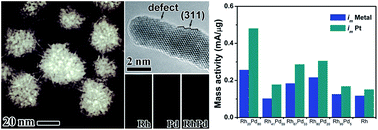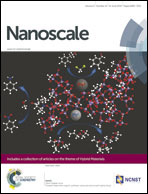Facile synthesis of Rh–Pd alloy nanodendrites as highly active and durable electrocatalysts for oxygen reduction reaction†
Abstract
In addition to activity, durability of Pd-based catalysts in a highly corrosive medium has become one of the most important barriers to limit their industrial applications such as low-temperature fuel cell technologies. Here, Rh with a unique capability to resist against oxidation etching was incorporated into Pd-based catalysts to enhance both their activity and durability for oxygen reduction reaction (ORR). This idea was achieved through the synthesis of the Rh–Pd alloy nanodendrites by co-reducing Rh and Pd salt precursors in oleylamine (OAm) containing cetyltrimethylammonium bromide (CTAB). In this synthesis, Rh–Pd alloy nanostructures with Rh–Pd atomic ratios from 19 : 1 to 1 : 4 were generated by varying the molar ratios of Rh and Pd salt precursors. Interestingly, this variation of the molar ratios of the precursors from Rh rich to Pd rich would lead to the shape evolution of Rh–Pd alloy from dendritic nanostructures to spherical aggregations. We found that Br− ions derived from CTAB were also indispensible to the production of Rh–Pd alloy nanodendrites. Owing to the addition of highly stable Rh as well as the radical structure with a large number of low-coordinated sites on the arms, Rh–Pd alloy nanodendrites with a Rh–Pd atomic ratio of 4 : 1 (Rh80Pd20) exhibited a substantially enhanced electrocatalytic performance towards ORR with a 5% loss of mass activity during the accelerated stability test for 10 000 cycles compared to ∼50% loss of the commercial Pt/C (E-TEK).


 Please wait while we load your content...
Please wait while we load your content...